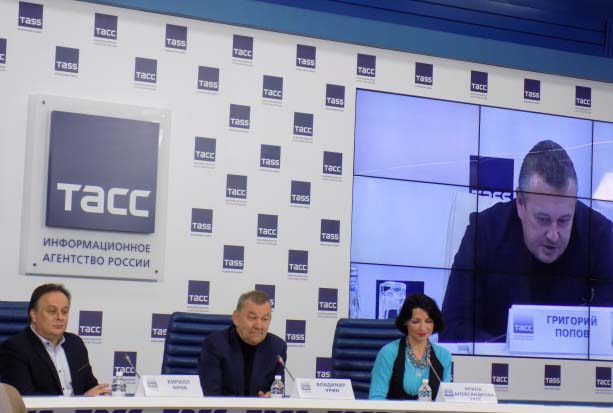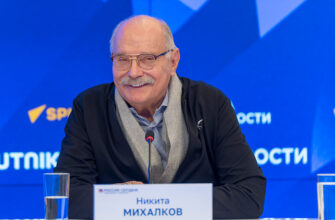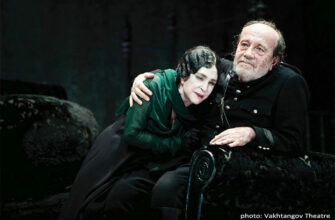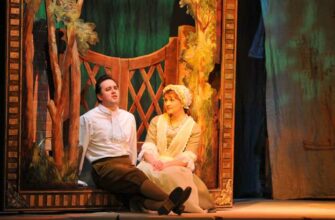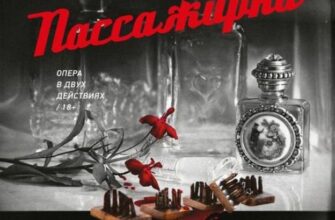We are witnessing today the stunning intensity of international cultural exchange. Cross years of culture and tourism are rapidly increasing geography: France, Greece, Slovenia, China … Cultural diplomacy flourished in all its glory, crisis and political battles it is not a hindrance.
Theaters – one of the brightest, the plenipotentiary diplomatic missions of cultural exchange. How feel the largest Russian theaters today in this role (official rating of theaters in 2016 at the end of the article)?
The TASS hosted a conference under the name “National Theaters: cultural diplomacy as the key to development”, and its content reminded me a funny story of life.
National theater in its modern interpretation
A few years ago, I arrived in Paris, went to the cashier of Opera Garnier (Grand Opera) and tried to buy tickets for real French setting. Alas, on all the days of my stay in the country German, Russian and Spanish authors, performers and troupes were listed in the poster.
“Monsieur, – I asked the cashier, – please tell me when can I see the real French opera performed by the French?”. The answer shocked me. Several times I asked again the poor man in different variants of French words, as long as were not convinced that everything is understood right. “You have come to the National Theater! Your chances of getting on the French opera in the sense that you understand it, are zero! “.
The National Opera House in France specializes exclusively in international cooperation and focuses on the world’s best achievements. Therefore, the opera there is German or Italian for the most part. And the best artists of the world. That is exactly what you mean by “National Theater”, théâtre national.
Festivals as a form of exchange of the National Theaters
At the press conference mentioned above Director of the Alexandrinsky Theater Grigory Popov shared the results of the 10th International Theatre Festival “Alexandrinsky”. He noted that the festival has expanded its geography and showed a lot of interesting productions in 2016.
For example, G. Popov highlighted the Hungarian National Theater (Nemzeti Szinhaz), which put the “Crime and Punishment” by F. M. Dostoevsky with Russian troupe. Artistic director of the theater – a graduate of the Theater Institute named after Karpenko-Karyi in Kyiv Atilla Vidnyansky.
The oldest national theater of Israel “Habima” (founded 100 years ago at the MAT in Moscow) brought “The Miser” by Jean-Baptiste Moliere.
Beijing National Art Theatre, “in shape is the European theater”, presented Chinese play “True Friends” written by Go Cihun.
Famous Japanese director Tadaci Sudzuki brought staging of Euripides “Trojan Women”.
According to Petrov, the festival revealed the problem of translation, which even in the synchronous version creates interference with the assimilation of the text. He did not find another problems.
Exchange is more intensive in Europe, according to participant of the press conference, Sergio Escobar (Piccolo Teatro di Milano) from Italy, on the Piccolo stage performances were in more than 30 languages this year. According to Escobar, cultural diplomacy of this kind allows enriching and fight an ideological adversary – nationalism. Apparently this is a stable global trend and it will be strengthened.
Russian theaters in the international context
All participants of the conference noted that Russia is actively engaged on the global arena. “I could never say that Russia is closed for joint cultural projects”, – said S. Escobar. According to the director of the theater named after E. Vakhtangov K. Kroc: “There are no barriers today for the promotion of Russian theater.”
Russian theaters are actively touring, they are invited to visit. A major role in this is played by “Federal Tour Center”. Statements with international actors and co-productions with other national theaters are widespread today. A striking example was the recent co-production “Oedipus the King” by theater named after E. Vakhtangov with the Athens National Theater, directed by Rimas Tuminas. Performance is in two languages. All theater projects are paid from three sources: the Ministry of Culture, sponsors and own funds.
Activity of national theaters on the international arena, according to the director of the Bolshoi Theater V. G. Urin needs the supporting the national culture center. “We have no center that promotes Russian culture”, – he complained and said that such centers have other European countries: the French Institute, the Goethe Institute in Germany, the British Council and etc. Taking into account the efforts for Russian export (creating a network of export centers) and tourism (Rostourism actively promotes incoming tourism), it is hoped that VG Urin will be heard.
Rating of theaters in Russia by the results of first half 2016
All three Russian national theater – Bolshoi, Alexandrinsky and Vakhtangov – are among the ten largest Russian theaters, according to information received by the cultural and political magazine “E Vesti” from the Ministry of Culture of the Russian Federation.
The rating included ten different theaters, enjoying a well-deserved success with the public and demonstrate both interesting performances and excellent quality of service to visitors. Mariinsky Theatre of St. Petersburg starts the top three, which demonstrated the highest traffic growth in the first half of 2016, it is followed by the Moscow Bolshoi Theater and the Moscow Art Theater named after Chekhov.
Mariinsky Theatre was founded by the decree of Empress Catherine the Great in 1783. Initially, it was called Bolshoy Kamennyi Theater, but after the construction of a new building in 1859 it was named Mariinsky in honor of Empress Maria Alexandrovna, wife of Alexander II. From 1935 to 1991 it was called Leningrad State Academic Opera and Ballet Theater named after S. M. Kirov. On January 16, 1992 it was returned former name to the theater – Mariinsky. Its history is connected with such names as Fedor Chaliapin, Anna Pavlova, Galina Ulanova, Rudolf Nureyev, Mikhail Baryshnikov, George Balanchine, Konstantin Korovin, Alexander Benois, Marius Petipa, and many others.
Bolshoi Theatre was founded in 1776 as a private theater of Prince Petr Urusov, when he received the assent of the Empress Catherine the Great “maintain … theatrical performances, as well as concerts and masquerades”. At that time it was named Petrovsky – on behalf of Petrovka Street. The new theater building was built in 1825, which was much greater than the former, so called Bolshoi Petrovsky. In 1856 it was built a new building, which has surpassed by its size the largest Italian theaters. At the same time the theater was renamed simply the Bolshoi Theater. In 1917, the Imperial Bolshoi Theater was renamed in the National Grand Theater.
Moscow Art Theater named after Anton Chekhov was established by K. S. Stanislavsky and V. I. Nemirovich-Danchenko in 1898. At first it was called Public-Art, from 1901 – the Moscow Art Theater (MAT), and from 1919 – the Moscow Academic Art Theater (MAAT). In 1932 it was named after M. Gorky. In 1987, it was divided into two theaters: Moscow Art Theater named after M. Gorky (under the direction of T. V. Doronina) and the Moscow Art Theater named after A. P. Chekhov (under the direction of O. N. Efremov).
Top-10 of the most visited theaters in Russia in the first half of 2016.
| # | The name of the theater | City | Number of visits, thous. people | Growth / Decline (yoy) | |
| 1st half of 2016 | 1st half of 2015 | ||||
| 1 | Mariinsky Theater | St. Petersburg | 863.5 | 674.9 | 27.9% |
| 2 | The Bolshoi Theater | Moscow | 281.0 | 291.8 | -3.7% |
| 3 | Moscow Art Theater named after A. P. Chekhov | Moscow | 200.1 | 165.5 | 20.9% |
| 4 | Theater named after E. Vakhtangov | Moscow | 197.6 | 180.1 | 9.7% |
| 5 | Moscow Art Theater named after M.Gorky | Moscow | 152.6 | 241.2 | -36.7% |
| 6 | Novosibirsk Opera and Ballet Theater | Novosibirsk | 149.8 | 142.4 | 5.2% |
| 7 | Maly Theater | Moscow | 145.9 | 119.2 | 22.4% |
| 8 | Yekaterinburg Opera and Ballet Theater | Ekaterinburg | 119.0 | 113.5 | 4.8% |
| 9 | Children’s Musical Theater named after N.I.Sats | Moscow | 99.3 | 89.2 | 11.3% |
| 10 | Russian Academic Youth Theater | Moscow | 97.5 | 95.3 | 2.3% |
Top-10 of the best theatrical organizations by the quality of service in Russia in the first half of 2016.
| # | The name of the theater | City | Overall score |
| 1 | Theater named after E. Vakhtangov | Moscow | 93.5 |
| 2 | State Pushkin Theater Center | St. Petersburg | 89.2 |
| 3 | Moscow State Philharmonic | Moscow | 86.6 |
| 4 | Russian Academic Youth Theater | Moscow | 86.0 |
| 5 | Maly Drama Theater | St. Petersburg | 85.5 |
| 6 | Moscow Art Theater named after M.Gorky | Moscow | 83.3 |
| 7 | St. Petersburg Philharmonic named after D. D. Shostakovich | St. Petersburg | 83.1 |
| 8 | North Caucasus Philharmonic named after V.I.Safonov | Kislovodsk | 81.6 |
| 9 | Alexandrinsky Theater | St. Petersburg | 81.3 |
| 10 | Theatre “Satyricon” named after A. Raikin | Moscow | 80.2 |
On the fourth line of rating – Theater named after Vakhtangov. We asked to comment the position of the theater its head, Kirill Igorevich Kroc.
Theater named after Vakhtangov was founded in 1913 as the Student Drama Studio led by Vakhtangov, actor and producer of the Moscow Art Theater. In 1920, the studio became the third studio of Moscow Art Theater. Foundation day of Theater is considered November 13, 1921, when the premiere held of “The Miracle of St. Anthony” of Maeterlinck staged by Vakhtangov. In 1926 the theater started to wear the name of its founder – Vakhtangov.
According to Kroc, “Let’s call all things by their proper names, we do not enter into the TOP10. We are the industry leaders on all indicators – the number of played performances, the number of spectators, at the amount of money from the authorized activity, that is from the sale of tickets, the money earned by the theater on tour, at the average wage, it is the highest in the industry, so we don’t enter any TOP10, we are industry leaders, and all the others out there in the top”.
EV: Can we know the key to success?
Kirill I. Croc: Good performances. Theater should lead the creative person who thinks about the theater, thinks about the viewer. We have such a man – Tuminas. That’s all. Theater – it is always the idea of art, the artistic leader. Lyubimov at the Taganka – theater was successful. No Lyubimov – theater is not. Theater arranged like this.
EV: I thought may be you feel the spirit of the time, may be are carrying a new artistic expression.
Kirill I. Croc: You and me can not feel anything. Feel can one man – the artist – feel the time, felt necessity of this time. If he feels right, then happens what we call success in the theater.
